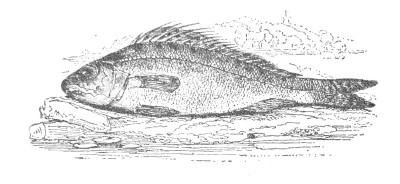| Web
and Book design,
Copyright, Kellscraft Studio 1999-2007 (Return to Web Text-ures) |
 (HOME)
|
|
Chapter 15.
OBSERVATIONS OF THE GUDGEON, THE RUFFE, AND THE BLEAK, AND HOW TO FISH
FOR THEM
PISCATOR.
The
Gudgeon is reputed a fish of excellent taste, and to be very wholesome:
he is
of a fine shape, of a silver color, and beautified with black spots
both on his
body and tail. He breeds two or three times in the year, and always in
summer.
He is com mended for a fish of excellent nourishment: the Germans call
him
Groundling, by reason of his feeding on the ground; and he there feasts
himself
in sharp streams, and on the gravel. He and the Barbel both feed so,
and do not
hunt for flies at any time, as most other fishes do: he is an excellent
fish to
enter a young Angler, being easy to be taken with a small red-worm, on
or very
near to the ground. He is one of those leather-mouthed fish that has
his teeth
in his throat, and will hardly be lost from off the hook if he be once
strucken. They be usually scattered up and down every river in the
shallows, in
the heat of summer; but in autumn, when the weeds begin to grow sour or
rot,
and the weather colder, then they gather together, and get into the
deeper
parts of the water. and are to be fished for there, with your hook
always
touching the ground, if you fish for him with a float, or with a cork.
But many
will fish for the Gudgeon by hand, with a running-line upon the ground,
without
a cork, as a Trout is fished for, and it is an excel lent way, if you
have a
gentle rod and as gentle a hand. There is
also
another fish called a Pope, and by some a Ruffe; a fish that is not
known to be
in some rivers: he is much like the Pearch for his shape, and taken to
be
better than the Pearch, but will not grow to be bigger than a Gudgeon:
he is an
excellent fish, no fish that swims is of a pleasanter taste, and he is
also
excellent to enter a young Angler, for he is a greedy biter, and they
will
usually lie, abundance of them together, in one reserved place, where
the water
is deep, and runs quietly; and an easy Angler, if he has found where
they lie,
may catch forty or fifty, or sometimes twice so many, at a standing. You must
fish for
him with a small red worm, and if you bait the ground with earth, it is
excellent. There is
also a
Bleak, or Fresh-water Sprat, a fish that is ever in Motion, and
therefore
called by some the River-Swallow; for just as you shall observe the
Swallow to
be, most evenings in summer, ever in motion, making short and quick
turns when
he flies to catch flies in the air, by which he lives, so does the
Bleak at the
top of the water. Ausonius would have him called Bleak, from his whit
ish
color: his back is of a pleasant sad or sea-water-green, his belly
white and
shining as the mountain snow. And, doubtless, though he have the
fortune, which
virtue has in poor people, to be neglected, yet the Bleak ought to be
much
valued, though we want Allamot-salt, and the skill that the Italians
have to
turn them into Anchovies. This fish may be caught with a Pater-noster
line;
that is, six or eight very small hooks tied along the line, one half a
foot
above the other: I have seen five caught thus at one time, and the bait
has
been gentles, than which none is better. Or this fish may be caught with a fine small artificial fly, which is to be of a very sad brown color, and very small, and the hook answerable. There is no better sport than whipping for Bleaks in a boat, or on a bank in the swift water in a summer's evening, with a hazel top about five or six foot long, and a line twice the length of the rod. I have heard Sir Henry Wotton say, that there be many that in Italy will catch swallows so, or especially martins, this bird-angler standing on the top of a steeple to do it, and with a line twice so long as I have spoken of: and let me tell you, Scholar, that both Martins and Bleaks be most excellent meat.  And let me tell you, that I have known a Hern that did constantly frequent one place caught with a hook baited with a big minnow or a small gudgeon. The line and hook must be strong, and tied to some loose staff, so big as she cannot fly away with it, — a line not exceeding two yards. |